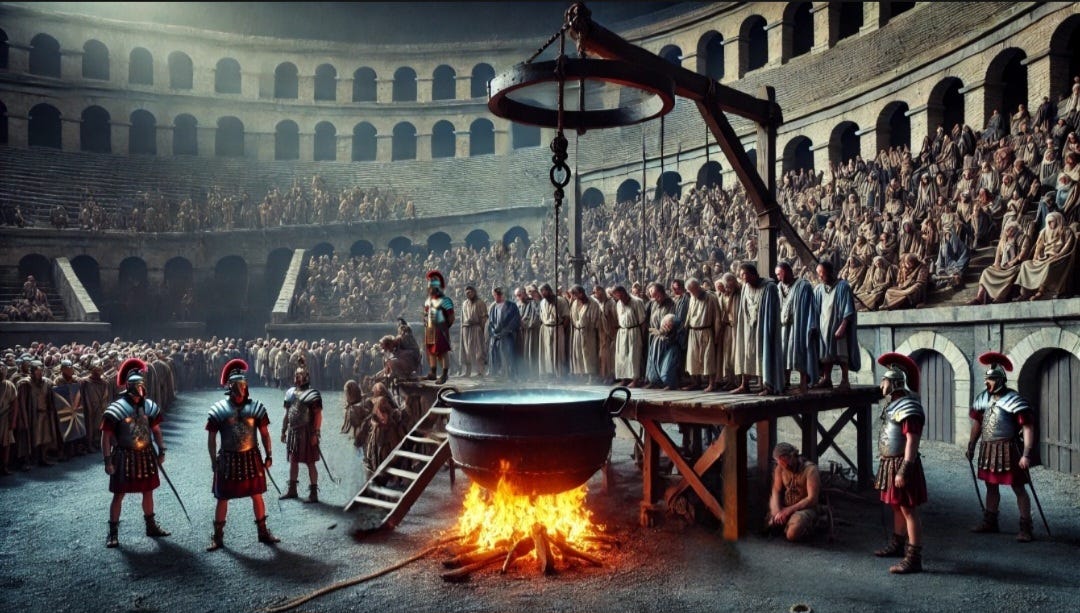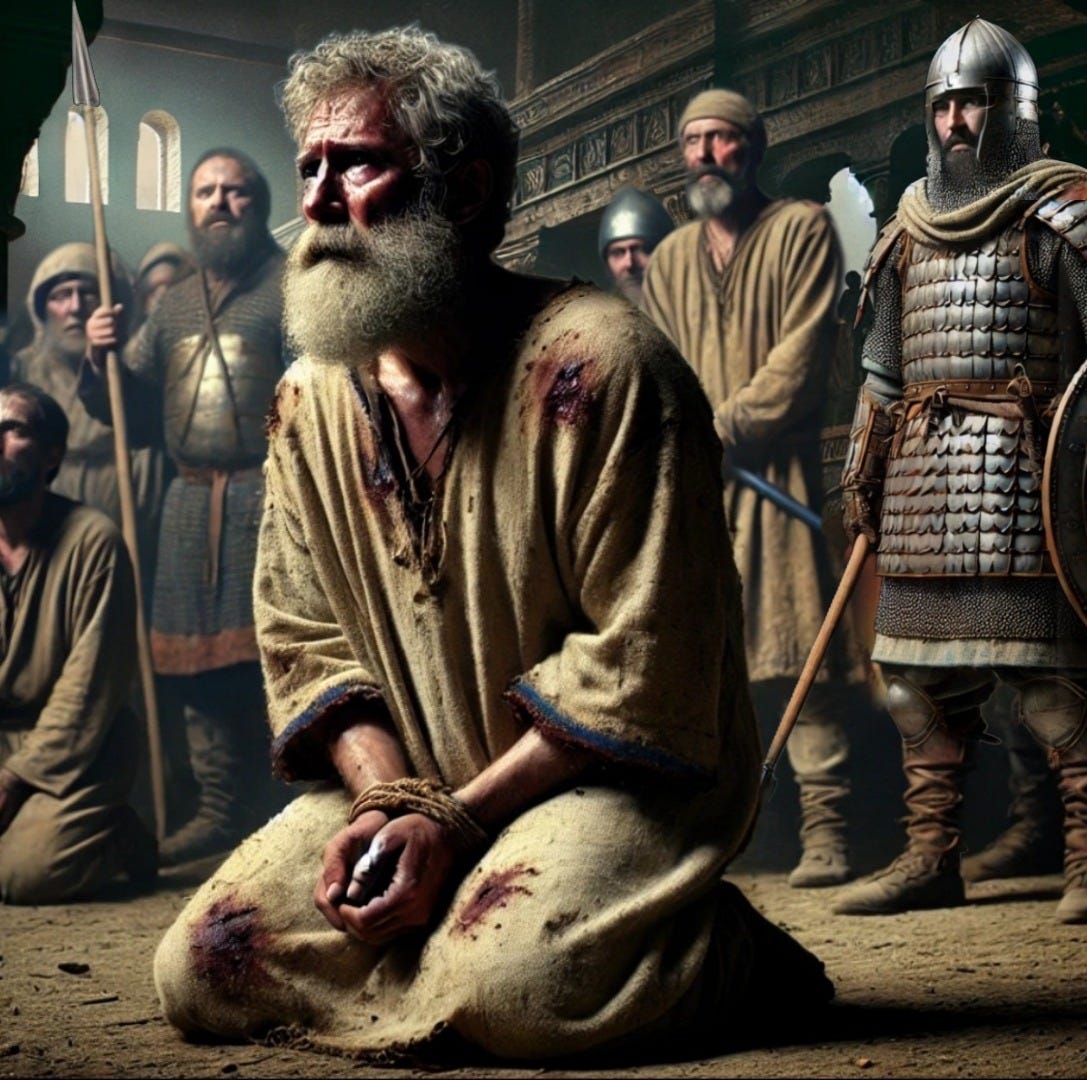"In her was found the blood of prophets and of God's holy people, of all who have been slaughtered on the earth." -Revelation 18:24
As the title says, this is simply a list of the persecution enacted toward Christians at the hands of the Roman Empire. A quick personal opinion: many of these atrocities bear a striking resemblance to the gruesome mechanizations of Nazi Germany (read more coming soon!). One has to wonder if the same principality oversaw both.
One additional observation about the scholarly treatment of these persecutions: There's often an almost clinical detachment in discussing what was fundamentally state-sanctioned bloodlust. The focus on legal frameworks and diplomatic aspects can obscure the human horror of people being torn apart by animals or burned alive simply for their beliefs. It's similar to how discussing the "legal framework" of Jim Crow or apartheid without acknowledging the profound human suffering would be deeply problematic. Anyway, for the sake of truth and thoroughness, here it is.
WARNING: CONTAINS DISTURBING DEPICTIONS OF CHRISTIAN PERSECUTION
1. NERONIAN PERSECUTION (64-68 AD)
GEOGRAPHIC SCOPE:
Focused specifically in Rome
TARGET GROUPS:
Christian population in Rome
CHARACTERISTICS:
First documented state persecution
Used Christians as scapegoats for Great Fire
METHODS/PUNISHMENTS:
Crucifixion
Dipped in hot tar or wax and burned as human torches
Fed to wild animals/dogs
Public spectacles of torture
HISTORICAL SIGNIFICANCE:
Set precedent for scapegoating Christians
NOTABLE MARTYRS:
Peter was crucified upside down upon his own request
Paul was beheaded
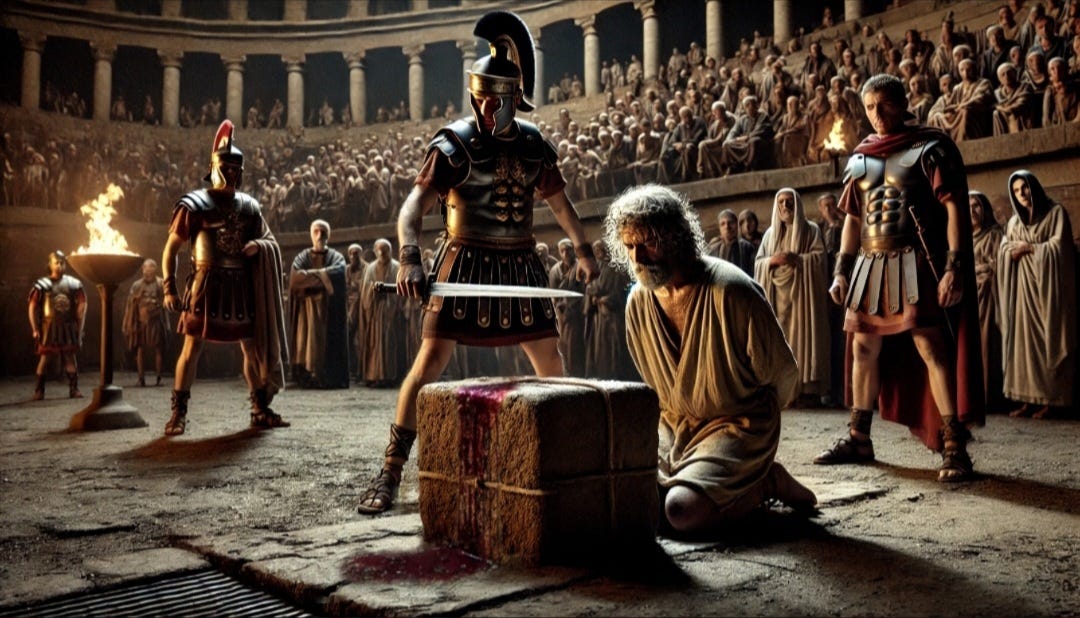
2. DOMITIAN'S PERSECUTION (81-96 AD)
GEOGRAPHIC SCOPE:
Empire-wide but sporadic
TARGET GROUPS:
Christians refusing imperial cult
Jewish communities
CHARACTERISTICS:
Mixed religious and political motivations
Emphasis on emperor worship
METHODS/PUNISHMENTS:
Exile to remote islands
Property confiscation
Forced participation in sacrifices as a loyalty test
Executions
HISTORICAL SIGNIFICANCE:
Strengthened link between imperial cult and persecution
Established religious conformity precedent
NOTABLE MARTYRS:
Flavius Clemens - Executed (method uncertain)
Antipas of Pergamum - According to tradition, roasted alive inside a bronze bull
John (survived) - Reportedly plunged into boiling oil before exile
Domitilla - Exiled rather than executed due to noble status
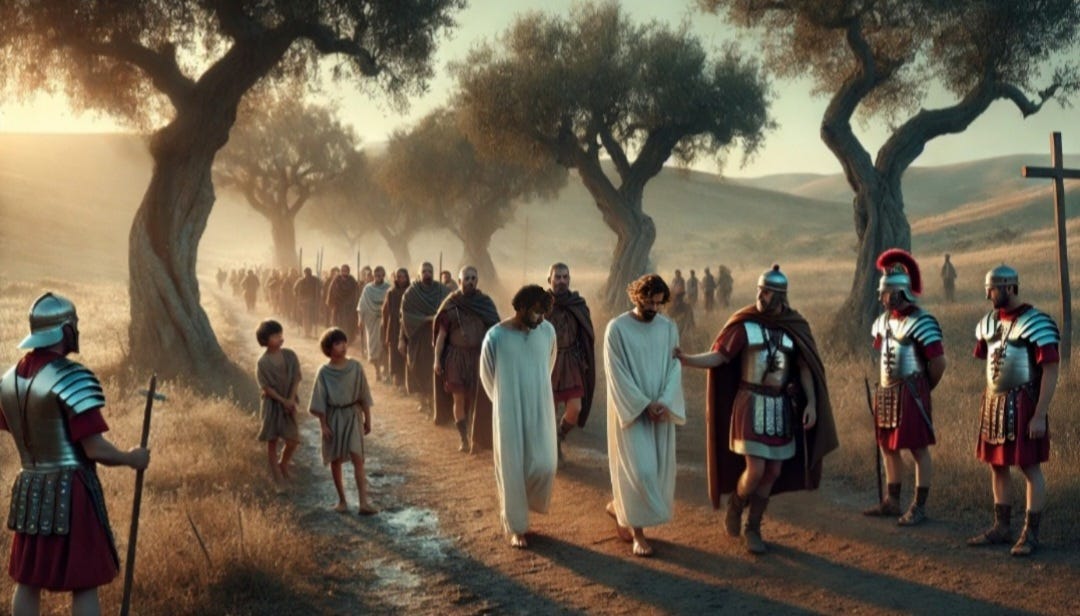
3. TRAJANIC PERSECUTION (98-117 AD)
GEOGRAPHIC SCOPE:
Empire-wide but reactive
TARGET GROUPS:
Publicly accused Christians
CHARACTERISTICS:
Christians not to be sought out
Anonymous accusations rejected
METHODS/PUNISHMENTS:
Opportunity to recant by sacrificing to emperor’s image and cursing Christ
Death for those refusing to recant
Beheading (for Roman citizens, considered more honorable)
Being thrown to wild beasts (damnatio ad bestias) in the arena
Public execution in the amphitheater
Burning at the stake
HISTORICAL SIGNIFICANCE:
Established legal framework
Created "don't ask, don't tell" approach
NOTABLE MARTYRS
Ignatius of Antioch - Thrown to lions in the Colosseum
Simeon of Jerusalem - Tortured and then crucified at age 120
Clement of Rome - Thrown into the sea with an anchor around his neck
Phocas - Thrown into a lime kiln, then boiling water
4. HADRIANIC PERIOD (117-138 AD)
GEOGRAPHIC SCOPE:
Empire-wide but locally initiated
TARGET GROUPS:
Specifically accused Christians
CHARACTERISTICS:
Required specific accusations
Prohibited anonymous denunciations
METHODS/PUNISHMENTS:
Burning alive
Being thrown to wild beasts
Beheading (for citizens)
Crucifixion
Punishment for false accusers
Torture before execution: Scourging/flagellation with metal-tipped whips, the rack for stretching limbs, red-hot metals/branding, iron claws/hooks (ungulae) to tear flesh, breaking/crushing limbs, hot oil/pitch/wax, suspension by various body parts, burning with torches before execution, the wheel (breaking bones systematically), starvation/exposure in prison, use of weights/stones to increase pain during suspension
HISTORICAL SIGNIFICANCE:
Established more regulated legal process
Protected against frivolous accusations
NOTABLE MARTYRS:
The case of Eustachius and his family is particularly horrific - they were reportedly roasted to death inside a bronze bull statue.
The deaths of Sophia's daughters were also brutal - they were tortured and killed one by one while their mother was forced to watch.

5. MARCUS AURELIUS PERIOD (161-180 AD)
GEOGRAPHIC SCOPE:
Focused in Gaul and Asia Minor
Particularly severe in Lyon and Vienne
TARGET GROUPS:
Urban Christian communities
Particularly targeted church leaders
Both wealthy and poor Christians affected
CHARACTERISTICS:
Permitted and even encouraged mob violence
Local authorities given broad discretion
Used torture to force recanting
Public spectacles of execution
Property confiscation common
METHODS/PUNISHMENTS:
Wild beasts in amphitheater
Burning at the stake
Scourging/flagellation
Imprisonment under harsh conditions
Red-hot iron chair
Systematic torture before execution
Bodies desecrated after death and thrown in rivers
HISTORICAL SIGNIFICANCE:
Demonstrated shift to local control over persecution
Led to increased Christian apologetic writing
Showed growing tension between imperial policy and local attitudes
First detailed accounts of systematic torture methods
Established precedent for using persecution to intimidate Christian communities
NOTABLE MARTYRS:
Polycarp of Smyrna: Burned alive when flames wouldn't touch him, then stabbed
Justin Martyr and companions: Scourged and beheaded
Martyrs of Lyon including:
Blandina: Tortured for days, suspended on a post for wild beasts, enclosed in a net and gored by a bull, finally killed
Pothinus (90-year-old bishop): Beaten, abused by mob, died in prison
Sanctus: Tortured with red-hot metal plates, survived initial torture, then killed
Maturus and Sanctus: Endured torture chair, wild beasts, more torture before death
Several others died in prison from conditions/torture
6. SEVERAN PERSECUTION (202-210 AD)
GEOGRAPHIC SCOPE:
Centered in Egypt, particularly Alexandria
North Africa, especially Carthage
Rome, though less frequent, more targeted
TARGET GROUPS:
New converts to Christianity
Teachers and evangelists
Christian educators/intellectuals
Catechumens (those preparing for baptism)
Parents who had their children baptized
CHARACTERISTICS:
Systematic effort to stop Christian growth
Specifically targeted conversion and education
Focus on intellectual/teaching centers
More organized than previous local persecutions
Used existing legal framework strategically
Enforced sacrificing to emperor/state gods
METHODS/PUNISHMENTS:
Beheading
Burning alive
Torture before execution including:
Scourging
The rack
Hot irons
Wild beasts in amphitheater
Prison conditions often fatal
Property confiscation
HISTORICAL SIGNIFICANCE:
First systematic attempt to stop Christianity's spread
Led to development of underground teaching networks
Influenced Christian education methods
Created precedent for targeting intellectual leaders
Demonstrated shift from reactive to preventive persecution
NOTABLE MARTYRS:
Perpetua and Felicitas (Carthage):
Perpetua: Young noble mother, tortured, gored by a heifer, finally killed by sword
Felicitas: Gave birth in prison, thrown to beasts with Perpetua
Leonidas (Origen's father): Beheaded
Potamiaena: Slowly lowered into boiling pitch
Basilides: Beheaded after converting during Potamiaena's execution
Several of Origen's students in Alexandria: Various execution methods
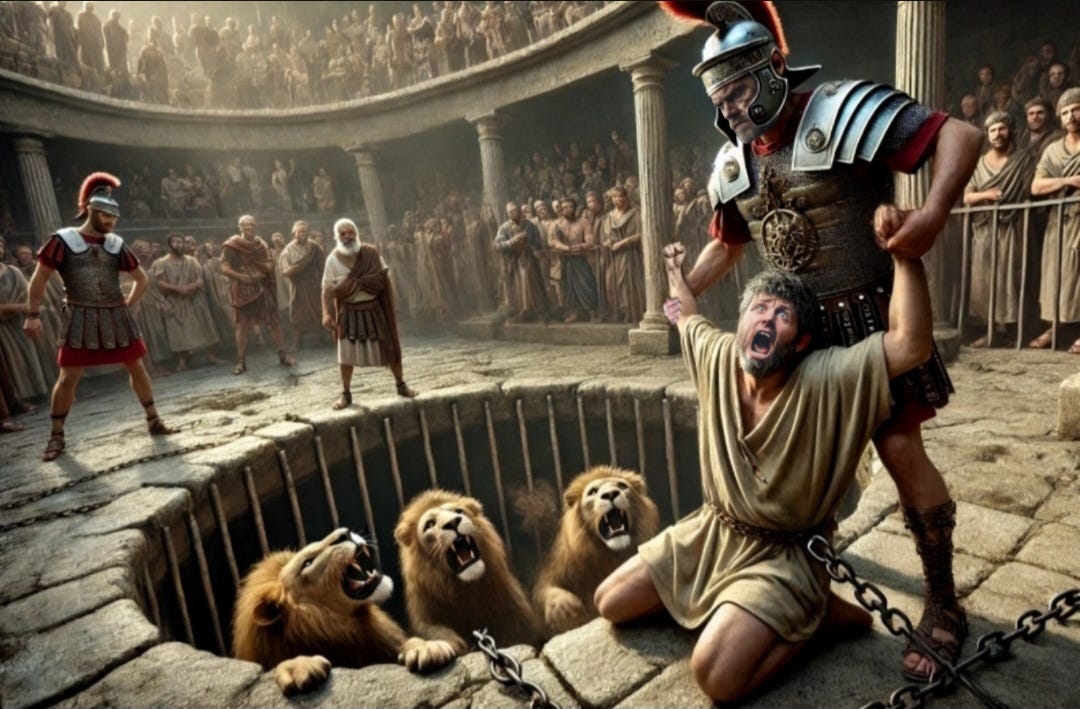
7. MAXIMINUS THRAX'S CAMPAIGN (235-238 AD)
GEOGRAPHIC SCOPE:
Major urban centers throughout empire
Particularly Cappadocia and Pontus
Significant activity in Rome
Notable persecution in Palestine
TARGET GROUPS:
Bishops and priests specifically targeted
Church leaders and teachers
Wealthy Christian patrons
Those harboring clergy
CHARACTERISTICS:
Strategic targeting of church hierarchy
Attempted to disrupt church organization
Combined political and religious motivation
Systematic identification of leaders
Used informant networks
METHODS/PUNISHMENTS:
Imprisonment under harsh conditions
Torture to extract information about other leaders
Execution methods included:
Burning alive
Beheading
Death by torture
Thrown to beasts
Property confiscation
Forced labor in mines
HISTORICAL SIGNIFICANCE:
Established precedent for targeting church leadership
Led to development of church contingency plans
Influenced hiding/protection networks for clergy
Showed shift to structural attack on church
Demonstrated vulnerability of visible church leaders
Led to more secretive church organization methods
NOTABLE MARTYRS:
Pope Pontian: Arrested, exiled to Sardinian mines, died from conditions/abuse
Hippolytus of Rome: Also died in Sardinian mines after torture
Bishop Anterus: Martyred after very brief papacy
Ambrose of Alexandria: Burned alive
Many unnamed clergy died in prisons or mines

8. DECIAN PERSECUTION (250-251 AD)
GEOGRAPHIC SCOPE:
Empire-wide, systematically implemented
Coordinated across all provinces
Urban and rural areas affected
Particularly severe in Rome, Egypt, Carthage, and Asia Minor
TARGET GROUPS:
All citizens required to participate
Special focus on Christian leaders
Wealthy Christians targeted first
Those refusing to sacrifice
Those caught with false certificates
Those helping others avoid sacrifice
CHARACTERISTICS:
Required universal sacrifice to gods/emperor
Certificate (libelli) system to prove compliance - pour libations, taste sacrificial meat, and acknowledge emperor's divinity
Set deadlines for compliance
Official commissions to oversee sacrifices
Public ceremonies required
Detailed records kept
Systematic house-to-house searches
METHODS/PUNISHMENTS:
Extensive torture methods:
Rack/stretching
Iron claws
Scourging
Burning with torches
Progressive amputation
Prolonged imprisonment under harsh conditions
Starvation in prison
Execution methods included:
Burning alive
Wild beasts
Beheading
Crucifixion
Confiscation of property
Exile to mines
HISTORICAL SIGNIFICANCE:
First empire-wide systematic persecution
Created precedent for bureaucratic persecution
Led to major church splits over treatment of lapsed Christians
Established methods for identifying Christians
Created lasting questions about faith under pressure
Influenced future systematic persecutions
Led to development of underground church networks
Changed Christian attitudes toward martyrdom
Created theological crises about forgiveness/readmission
NOTABLE MARTYRS:
Pope Fabian: Tortured and beheaded
Pionius of Smyrna: Nailed to stake and burned alive
Alexander of Jerusalem: Died under torture in prison
Babylas of Antioch: Died in chains
Carpus and Papylus: Burned alive
Agatha of Sicily: Tortured with red-hot irons, breast amputation, rolled on shards
Many unnamed Christians died from prison conditions

9. VALERIANIC PERSECUTION (257-259 AD)
GEOGRAPHIC SCOPE:
Systematic empire-wide enforcement
Particularly severe in Rome, North Africa, Spain
Heavy persecution in Egypt and Asia Minor
Urban and rural areas affected
TARGET GROUPS:
Christian clergy at all levels
Wealthy Christian families
Christian civil servants
Christian aristocrats
Those attending Christian assemblies
Those harboring Christian leaders
CHARACTERISTICS:
Two-phase approach:
First edict targeted clergy and assemblies
Second edict targeted wealthy Christians and nobles
Economic warfare through confiscation
Required clergy registration with authorities
Banned Christian gatherings
Combined financial and physical persecution
METHODS/PUNISHMENTS:
Torture methods included:
Scourging/flagellation
The rack
Iron hooks
Burning with torches
Progressive torture to force compliance
Executions by:
Beheading
Burning alive
Wild beasts
Crucifixion
Forced labor in mines
Harsh imprisonment
Total property confiscation
Exile
HISTORICAL SIGNIFICANCE:
Created model for economic persecution
Demonstrated effectiveness of targeting church wealth
Led to development of hidden property networks
Changed church attitudes toward wealth
Influenced church-state relations
Showed vulnerability of visible church property
Led to more secretive financial practices
Established pattern of targeting both leaders and resources
NOTABLE MARTYRS:
Pope Sixtus II: Caught in catacombs, beheaded with four deacons
Lawrence of Rome: Grilled alive on iron grate
Cyprian of Carthage: Beheaded after refusing to sacrifice
Fructuosus: Burned alive with his deacons
Numerous unnamed wealthy Christians and clergy who died in mines or prison

10. GREAT PERSECUTION (303-311 AD)
GEOGRAPHIC SCOPE:
Comprehensive empire-wide campaign
Particularly severe in Eastern Empire
Varied enforcement in Western Empire
Urban and rural areas systematically targeted
TARGET GROUPS:
All Christians regardless of status
Clergy especially targeted
Christian soldiers and officials
Christian households
Those possessing scriptures
Those attending services
Those harboring Christians
CHARACTERISTICS:
Four Edicts with escalating severity:
Church/scripture destruction, civil rights removed
Clergy arrest and forced sacrifice
Clergy torture/execution if refusing sacrifice
Universal sacrifice requirement or death
METHODS/PUNISHMENTS:
Mass executions including:
Burning alive in groups
Mass drownings
Beheading
Wild beasts
Crucifixion
Systematic torture methods:
Rack/stretching
Iron claws
Scourging to bone
Vinegar/salt in wounds
Slow burning
Progressive mutilation
Church destruction
Scripture burning
Property confiscation
Forced labor in mines
Imprisonment under harsh conditions
HISTORICAL SIGNIFICANCE:
Most severe and comprehensive persecution
Led to widespread trauma in Christian communities
Created major divisions over how to handle those who lapsed
Demonstrated the resilience of Christian faith under extreme pressure
Created a foundation for later "orthodox" persecution of other Christians
Set precedent for systematic persecution methods that would be used against "heretical" Christians after Nicaea
Led to massive loss of early Christian texts and practices
Created conditions that Constantine later exploited for political power
NOTABLE MARTYRS:
Peter of Alexandria: Beheaded
Phileas: Beheaded after torture
Lucy of Syracuse: Multiple tortures, finally killed by sword
Agnes of Rome: Young girl, tortured and killed
Eulalia of Mérida: 12 years old, multiple tortures including:
Flesh torn with hooks
Burning with torches
Finally burned alive
Thousands of unnamed Christians killed in groups
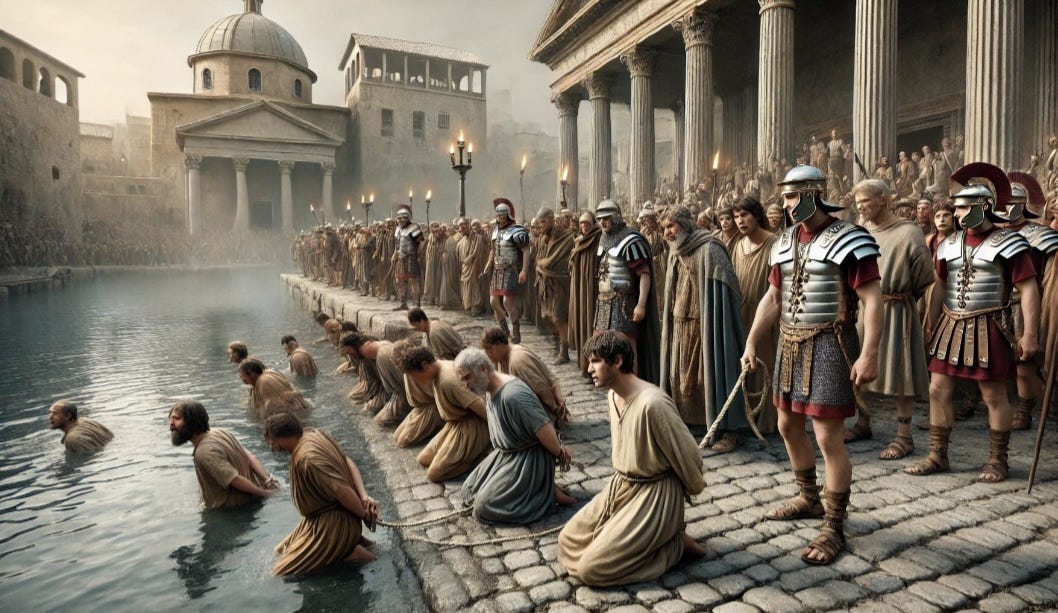
11. ANTI-ARIAN PERSECUTION (325-381 AD)
GEOGRAPHIC SCOPE:
Empire-wide systematic persecution
Most intense in Eastern Empire
Particularly severe in Alexandria and other major cities
Special focus on areas with high Arian populations
Strategic targeting through episcopal sees
TARGET GROUPS/"HERETICAL" BELIEFS:
Groups:
Arian clergy and bishops
Congregations refusing Nicene Creed
Anyone questioning Jesus' full divinity
Those possessing Arian texts
Those harboring Arian teachers
Anyone suspected of Arian sympathies
Communities refusing to recant
Beliefs:
Rejected that Jesus was God Himself
Taught that Jesus was divine but created by God
Maintained that Jesus was the highest of all divine beings but subordinate to God
Emphasized "there was a time when the Son was not"
Rejected that Jesus was co-eternal or "of the same substance" (homoousios) with God
Viewed Christ as uniquely divine but fundamentally distinct from and lesser than God the Father
Interpreted biblical passages about Jesus' submission to the Father as evidence of his subordinate divine status
CHARACTERISTICS:
State-church coordinated persecution
Use of "reconciliation" process as coercion
Systematic destruction of texts/teachings
Legalized/incentivized mob violence
Episcopal sees used to control territory
Combined religious and political oppression
Used memory of previous persecutions as leverage
METHODS/PUNISHMENTS:
Physical Violence:
Torture
Public beatings
Mob attacks with impunity
Execution of those refusing to recant
Breaking of limbs
Burning
Institutional Persecution:
Property confiscation
Church seizures
Book burning
Exile of leaders
Economic exclusion
Social ostracism
Loss of civil rights
Forced "reconciliation"
Banned assemblies
HISTORICAL SIGNIFICANCE:
Established violent orthodoxy enforcement
Created precedent for "legitimate" persecution of other Christians
Showed how quickly persecuted could become persecutors
Demonstrated merger of church and state power
Set pattern for future anti-heretical campaigns
Led to loss of early Christian diversity
Cemented institutional control over doctrine
Created lasting trauma within Christian communities
Established use of creeds as control mechanisms
NOTABLE MARTYRS/VICTIMS:
Arius himself (suspicious death before reinstatement)
Eusebius of Nicomedia (initially exiled)
Theognis of Nicaea (exiled)
Countless unnamed Arians killed by mobs
Families torn apart
Communities scattered

12. ANTI-DONATIST PERSECUTION (347-411 AD)
GEOGRAPHIC SCOPE:
Centered in North Africa, especially Numidia
Most intense in Carthage
Spread across North African provinces
Particularly affected rural areas and small towns
TARGET GROUPS/”HERETICAL” BELIEFS:
Donatists who believed:
Church must remain pure
Sacraments invalid if performed by traditores (those who surrendered scriptures during persecution)
Church should be separate from state
Rebaptism necessary for those baptized by traditores
Anyone who supported their stance
Communities harboring Donatist clergy
Those refusing to accept Catholic bishops
Opposing church-state merger under Constantine
CHARACTERISTICS:
State-backed military campaigns
Systematic church seizures
Economic warfare against communities
Use of "unity by force" doctrine
Collaboration between state and Catholic Church
Imperial edicts enforcing compliance
Mob violence encouraged
METHODS/PUNISHMENTS:
Physical Violence:
Torture to force submission
Beatings by soldiers
Execution of resistant leaders
Military attacks on communities
Mob violence against congregations
Institutional Persecution:
Church building confiscation
Property seizure
Forced "reconciliation"
Loss of inheritance rights
Bans on assemblies
Economic restrictions
Exile of clergy
Destruction of texts
HISTORICAL SIGNIFICANCE:
First use of military forces against Christian "heretics"
Augustine's development of "just persecution" theology
Established precedent for violent suppression of dissent
Created template for church-state persecution
Showed how institutional violence could be theologized
Set pattern for future "corrections" of "heresy"
Demonstrated shift from martyrdom to persecution
NOTABLE MARTYRS:
Marculus: Thrown from a cliff by Catholic forces
Isaac and Maximian: Killed during forced "unity" campaign
Many unnamed Donatists killed in:
Church seizures
Military raids
Mob attacks
Prison conditions
Entire communities scattered or destroyed
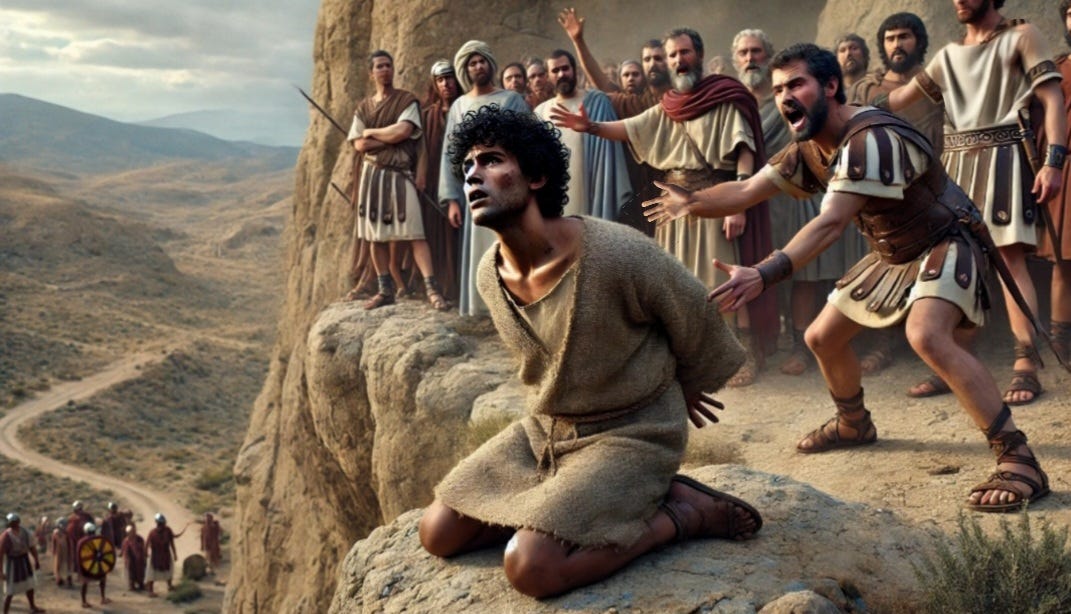
13. ANTI-PRISCILLIAN PERSECUTION (380-385 AD)
GEOGRAPHIC SCOPE:
Centered in Hispania (modern Spain)
Extended into Southern Gaul
Particularly severe in Avila and Trier
Affected rural ascetic communities
TARGET GROUPS/”HERETICAL” BELIEFS:
Groups:
Priscillianist clergy and followers
Ascetic communities - strict self-denial and abstaining from worldly pleasures/luxuries
Women in teaching/leadership roles
Independent Bible study groups
Supporters of church poverty
Those accused of Manichean practices
Anyone harboring targeted groups
Beliefs:
Rejected that Jesus was God Himself
Taught Jesus was divine but subordinate to God
Church Structure/Authority:
Promoted individual scripture study/interpretation
Opposed church hierarchy and wealth
Allowed women to teach scripture
Required strict ascetic practices
False Accusations:
Manichean dualism
Sorcery/magic
Secret immoral practices
CHARACTERISTICS:
First execution of heretics by state
Use of civil courts rather than church courts
Use of torture to extract confessions
Collaboration between hostile bishops and state
Property seizure as motivation
False accusations of magic/Manichaeism
Political manipulation of religious charges
METHODS/PUNISHMENTS:
Physical Violence:
Torture for confessions
Beheading of leaders
Prison conditions
Public humiliation
Institutional Persecution:
Property confiscation
Exile
Loss of civil rights
Church property seizure
Book burning
Banned assemblies
Forced recantations
HISTORICAL SIGNIFICANCE:
First execution of "heretics" by Christian state
Established use of civil courts for religious trials
Created precedent for death penalty in heresy cases
Showed how religious charges could mask political motives
Demonstrated dangerous merger of church and state power
Led to debates about proper handling of "heretics"
NOTABLE MARTYRS:
Priscillian of Avila: Tortured and beheaded
Six of his followers executed with him:
Two priests
Two deacons
Latronianus (poet)
Euchrotia (noblewoman)
Many unnamed followers:
Exiled
Died from torture
Imprisoned
Lost property/status

14. ANTI-NOVATIAN PERSECUTION (380-439 AD)
GEOGRAPHIC SCOPE:
Empire-wide suppression
Focused in major urban centers
Particularly active in Rome and Constantinople
Present in Asia Minor
TARGET GROUPS/”HERETICAL” BELIEFS:
Groups:
Novatian clergy and bishops
Novatian congregations
Those harboring Novatianists
Communities refusing to integrate
Supporters of Novatian practices
Beliefs:
Rejected Jesus as God Himself
Viewed Jesus as divine but subordinate
Opposed readmission of lapsed Christians
Required rebaptism for the lapsed
Demanded strict moral purity
Rejected marriage after baptism
Required stricter penance
CHARACTERISTICS:
Systematic absorption strategy
Gradual property confiscation
Church building seizures
Forced congregational mergers
Economic pressure tactics
Administrative suppression
METHODS/PUNISHMENTS:
Church building confiscation
Property seizure
Forced church closures
Mandatory integration with orthodox churches
Economic restrictions
Loss of assembly rights
Exile of resistant clergy
Destruction of texts/records
HISTORICAL SIGNIFICANCE:
Established model for absorbing dissenting groups
Demonstrated "soft" persecution tactics
Showed effectiveness of economic pressure
Created pattern for forced church mergers
Influenced later suppression methods
Proved effectiveness of gradual approach
NOTABLE MARTYRS:
Fewer dramatic martyrdoms due to "soft" tactics
Many clergy forced into exile
Communities scattered through forced integration
Leaders who resisted absorption lost positions/property
Congregations dissolved through economic pressure

15. ANTI-PELAGIAN PERSECUTION (418-431 AD)
GEOGRAPHIC SCOPE:
Originated in North Africa
Spread across Western Empire
Reached Constantinople
Particularly active in Rome and Carthage
TARGET GROUPS/”HERETICAL” BELIEFS:
Groups:
Pelagian teachers and writers
Supportive bishops and clergy
Monastic communities
Intellectual followers
Sympathetic church leaders
Anyone promoting Pelagian ideas
Beliefs:
Rejected Jesus as God Himself
Taught humans could achieve righteousness through free will
Denied inherited original sin
Believed divine grace wasn't necessary for salvation
Taught people could live sinlessly through effort
Emphasized human moral responsibility
Rejected predestination
Supported ascetic discipline
CHARACTERISTICS:
Systematic theological suppression
Imperial edicts enforcing orthodoxy
Church-state cooperation
Academic/intellectual persecution
Destruction of writings
Ecclesiastical trials
METHODS/PUNISHMENTS:
Exile of teachers and leaders
Property confiscation
Removal from church offices
Book burning
Loss of teaching positions
Economic restrictions
Social ostracism
Banned from teaching
Forced recantations
HISTORICAL SIGNIFICANCE:
Strengthened papal doctrinal authority
Established orthodox position on grace
Created precedent for suppressing theological ideas
Enhanced church control over teaching
Demonstrated church-state persecution cooperation
Influenced Western theology on salvation
NOTABLE MARTYRS:
Pelagius (exiled to Palestine)
Celestius (banished from Rome)
Julian of Eclanum (stripped of position, exiled)
Many unnamed monks and teachers:
Lost positions
Forced into exile
Reduced to poverty
Silenced through threats
16. ANTI-NESTORIAN PERSECUTION (431-489 AD)
GEOGRAPHIC SCOPE:
Centered in Eastern Empire
Most intense in Constantinople
Spread through Asia Minor
Affected School of Edessa
TARGET GROUPS/”HERETICAL” BELIEFS:
Groups:
Nestorian clergy and bishops
Theological school teachers/students
Eastern Christian communities
Scholars and intellectuals
Monasteries following Nestorian teaching
Syrian Christian communities
Beliefs:
Rejected Jesus as God Himself
Taught Mary was mother of Christ but not "Mother of God"
Emphasized distinction between Christ's human/divine natures
Opposed calling Mary "Theotokos" (God-bearer)
Maintained Christ's natures were separate
Rejected complete divine-human union in Christ
CHARACTERISTICS:
Coordinated church-state persecution
Systematic theological suppression
Closure of educational institutions
Destruction of theological texts
Exile of entire communities
Cultural/linguistic suppression
METHODS/PUNISHMENTS:
Mass book burning
Monastery closures
Forced exile
Property confiscation
School closures
Teaching bans
Loss of positions
Economic restrictions
Destruction of writings
Forced recantations
HISTORICAL SIGNIFICANCE:
Pushed Christianity eastward into Persia
Created permanent East-West church divide
Led to development of separate Eastern traditions
Destroyed important theological texts
Influenced development of Eastern Christianity
Demonstrated power of theological persecution
NOTABLE MARTYRS:
Nestorius himself (died in exile in Egypt)
Teachers from School of Edessa
Scholars forced to flee east
Entire communities displaced
Many clergy exiled to desert regions
Countless unnamed followers who lost homes/livelihoods

17. ANTI-MONOPHYSITE PERSECUTION (451-519 AD)
GEOGRAPHIC SCOPE:
Eastern Empire dominantly
Severe in Egypt (Alexandria)
Intense in Syria
Spread through Palestine
Affected parts of Armenia
TARGET GROUPS/”HERETICAL” BELIEFS:
Groups:
Monophysite clergy and bishops
Egyptian monks and monasteries
Syrian Christian communities
Coptic Christians
Armenian Christians
Desert monastic communities
Anyone rejecting Chalcedon Council
Beliefs:
Rejected Jesus as human, viewed him as completely divine
Taught Christ had one nature (divine), not two
Opposed Chalcedonian "two natures" doctrine
Emphasized Christ's divinity over humanity
Rejected imperial control of doctrine
Maintained local Christian traditions
CHARACTERISTICS:
Extreme military violence
Systematic suppression
State-backed persecution
Cultural/ethnic targeting
Mass resistance to enforcement
Regional uprisings
Violent church takeovers
METHODS/PUNISHMENTS:
Military attacks on communities
Torture of resisters
Mass killings
Church confiscation
Forced exile
Monastery raids
Property seizure
Public beatings
Imprisonment
Economic sanctions
Destruction of texts
HISTORICAL SIGNIFICANCE:
Split Eastern Christianity permanently
Weakened Byzantine control in Egypt/Syria
Created independent Oriental churches
Led to development of Coptic Church
Fueled anti-imperial sentiment
Contributed to later Islamic conquests
Destroyed regional Christian unity
NOTABLE MARTYRS:
Thousands killed in Alexandria riots
Egyptian monks slaughtered in monasteries
Syrian clergy tortured and executed
Desert fathers driven from communities
Entire villages displaced
Many died resisting church seizures
Countless unnamed victims of military violence

18. ANTI-MANICHAEAN PERSECUTION (527-565 AD under Justinian)
GEOGRAPHIC SCOPE:
Empire-wide systematic persecution
Most severe in Constantinople
Active in Asia Minor
Present in major urban centers
Extended into Persian territories
TARGET GROUPS/”HERETICAL” BELIEFS:
Groups:
Manichaean believers and teachers
Suspected dualist sympathizers
Related gnostic sects
Anyone accused of Manichaeism
Traders from Persian regions
Intellectual communities
Those possessing Manichaean texts
Beliefs:
Rejected Jesus as God Himself
Taught Jesus was purely spirit/divine
Believed in two opposing forces (light/darkness)
Denied Christ's physical incarnation
Rejected physical resurrection
Taught material world was evil
Followed dualistic cosmology
Required strict ascetic practices
CHARACTERISTICS:
First systematic execution program
Death penalty implementation
Total elimination attempt
Use of informant networks
Public executions
Comprehensive legal framework
Incentivized accusations
METHODS/PUNISHMENTS:
Burning alive
Property confiscation
Forced exile
Civil rights revocation
Citizenship loss
Book burning
Trade restrictions
Social ostracism
Torture for information
Imprisonment
Asset seizure
HISTORICAL SIGNIFICANCE:
Established burning as heretic punishment
Created template for medieval heresy laws
Introduced death penalty for beliefs alone
Set precedent for systematic elimination
Influenced later inquisition methods
Established informant systems
Created legal framework for executions
NOTABLE MARTYRS:
Many burned alive in Constantinople
Entire communities forced underground
Teachers and leaders executed publicly
Merchants executed on suspicion
Families destroyed through accusations
Unknown numbers killed through informants
Many died in prison or exile

19. ANTI-COPTIC PERSECUTION (590-640 AD)
GEOGRAPHIC SCOPE:
Centered in Egypt
Particularly severe in Alexandria
Extended through Nile Valley
Affected Delta region
Reached into Nubia
TARGET GROUPS/”HERETICAL” BELIEFS:
Groups:
Coptic clergy and bishops
Egyptian monasteries
Native Egyptian Christians
Coptic monks and nuns
Egyptian church leaders
Rural Christian communities
Anyone rejecting Chalcedon
Beliefs:
Rejected Jesus’ continuing human nature
Maintained Monophysite doctrine (Christ's single nature)
Opposed Chalcedonian "two natures" teaching
Preserved ancient Egyptian Christian traditions
Rejected Byzantine religious authority
Maintained independent church hierarchy
Used Coptic language in worship
CHARACTERISTICS:
Byzantine military enforcement
Systematic cultural suppression
Violent church takeovers
Economic warfare
Language suppression
Administrative control attempts
Institutional displacement
METHODS/PUNISHMENTS:
Church building confiscation
Monastery seizures
Torture of resisters
Property theft
Forced Greek language use
Economic restrictions
Physical beatings
Leadership replacement
Resource deprivation
Text destruction
Travel restrictions
HISTORICAL SIGNIFICANCE:
Severely weakened Byzantine control
Led to Egyptian support of Arab invasion
Deepened Egyptian-Byzantine divide
Contributed to Islamic conquest success
Strengthened Coptic identity
Created lasting religious divisions
Damaged Byzantine legitimacy
NOTABLE MARTYRS:
Numerous Coptic monks tortured
Egyptian priests killed defending churches
Monastery leaders died resisting seizures
Communities scattered by violence
Many died from torture/imprisonment
Unknown numbers killed in church raids
Families destroyed through persecution

20. ANTI-CELTIC CHRISTIAN PERSECUTION (604-640 AD)
GEOGRAPHIC SCOPE:
British Isles broadly
Northern Britain especially
Irish monasteries
Welsh Christian centers
Scottish communities
TARGET GROUPS/”HERETICAL” BELIEFS:
Groups:
Celtic Christian clergy
Irish monastic communities
Native British church leaders
Celtic monks and scholars
Indigenous Christian teachers
Local Christian communities
Anyone maintaining Celtic practices
Beliefs:
Rejected Roman ecclesiastical authority
Maintained older Christian traditions
Used different dating for Easter
Followed Celtic tonsure practices
Preserved apostolic simplicity
Emphasized monastic spiritual authority
Maintained independent church governance
CHARACTERISTICS:
Systematic cultural suppression
Roman ritual enforcement
Gradual institutional takeover
Replacement of leadership
Erasure of Celtic traditions
Administrative absorption
Cultural colonization
METHODS/PUNISHMENTS:
Monastery takeovers
Clergy replacement
Property confiscation
Forced conformity to Roman practices
Economic pressure
Leadership removal
Resource control
Teaching restrictions
Text suppression
Ritual bans
Travel limitations
HISTORICAL SIGNIFICANCE:
Romanized British Christianity
Suppressed native Christian traditions
Destroyed unique Celtic practices
Centralized church control
Eliminated independent traditions
Standardized worship practices
Created lasting cultural loss
NOTABLE MARTYRS:
While fewer violent deaths than other persecutions, many suffered through:
Forced exile from monasteries
Loss of positions and authority
Community displacement
Cultural destruction
Poverty after property seizure
Death from exposure/deprivation
Loss of ancient traditions
21. ANTI-MONOTHELITE PERSECUTION (680-711 AD)
GEOGRAPHIC SCOPE:
Eastern Empire dominantly
Centered in Constantinople
Heavy in Syria
Present in Palestine
Extended through Asia Minor
TARGET GROUPS/”HERETICAL” BELIEFS:
Groups:
Monothelite clergy and bishops
Syrian Christian communities
Supporters of Sergius's compromise
Theological moderates
Eastern monasteries
Anyone rejecting Sixth Council (declared that Jesus had two wills— divine and human)
Compromise-seeking Christians
Beliefs:
Rejected Jesus as having human will
Taught Christ had two natures but one will
Sought compromise between Chalcedon/Monophysites
Maintained Christ's human nature was passive
Emphasized unity of Christ's person
Supported peaceful theological resolution
Rejected extreme Chalcedonian position
CHARACTERISTICS:
Combined political/theological purge
Imperial enforcement
Church-sanctioned persecution
Systematic elimination of compromise
Hardline orthodox enforcement
Destruction of reconciliation attempts
METHODS/PUNISHMENTS:
Formal anathematization
Clergy exile
Church property seizure
Text destruction
Position removal
Economic sanctions
Teaching bans
Ritual exclusion
Community isolation
Theological censorship
Travel restrictions
HISTORICAL SIGNIFICANCE:
Weakened Byzantine Syrian control
Deepened East-West church divide
Destroyed possibility of compromise
Alienated Syrian Christians
Contributed to Islamic expansion
Hardened theological positions
Eliminated moderate voices
NOTABLE MARTYRS:
Patriarch Sergius (condemned posthumously)
Pope Honorius (condemned posthumously)
Exiled clergy who died in banishment
Syrian bishops removed from office
Teachers forced into silence
Communities scattered
Many died in exile/poverty

22. ANTI-PAULICIAN PERSECUTION (begins ~650 AD)
GEOGRAPHIC SCOPE:
Started in Armenia
Spread through Eastern Empire
Throughout Asia Minor
Reached Constantinople
Extended into Balkans
TARGET GROUPS/”HERETICAL” BELIEFS:
Groups:
Paulician communities
Associated merchants/traders
Suspected dualist sympathizers
Armenian Christians
Paulician teachers
Anyone possessing their texts
Those offering shelter/support
Beliefs:
Rejected Jesus as God Himself
Taught Christ brought soul from heaven
Denied physical incarnation
Rejected church hierarchy
Opposed use of images/icons
Emphasized direct spiritual knowledge
Rejected sacraments and rituals
Taught salvation through knowledge
CHARACTERISTICS:
Military elimination campaigns
Systematic extermination attempts
Mass violence approach
State-sponsored killing
Cultural destruction efforts
Complete suppression goal
Forced population transfers
METHODS/PUNISHMENTS:
Mass executions
Burning at stake
Property confiscation
Forced resettlement
Military attacks
Book burning
Torture
Community destruction
Trade restrictions
Asset seizure
Public executions
Family separation
HISTORICAL SIGNIFICANCE:
Established medieval dualist persecution patterns
Led to Paulician military resistance
Created refugee movements
Influenced later Bogomil/Cathar persecutions
Demonstrated shift to mass violence
Set precedent for total elimination campaigns
Led to armed religious resistance
NOTABLE MARTYRS:
Constantine-Silvanus (founder, stoned to death)
Simeon-Titus (burned at stake)
Sergius-Tychicus (killed by sword)
Thousands killed in mass executions
Entire communities burned alive
Many died in forced marches
Unknown numbers killed in military campaigns
The Anti-Paulician persecution lasted from around 650 AD until the 9th century, with several intense waves:
650s - Initial persecutions begin
690s - Intensification under Justinian II
813-820 - Major persecution under Leo V
843-867 - Most violent period under Theodora and Michael III (including mass executions)
The Byzantine Empress Theodora allegedly had:
100,000 Paulicians killed
Methods included beheading, drowning, crucifixion
Property seized
Children taken
Communities destroyed
But the Paulicians:
Established their own state
Fought back militarily
Some fled to Armenia
Some survived in remote areas
Some went underground
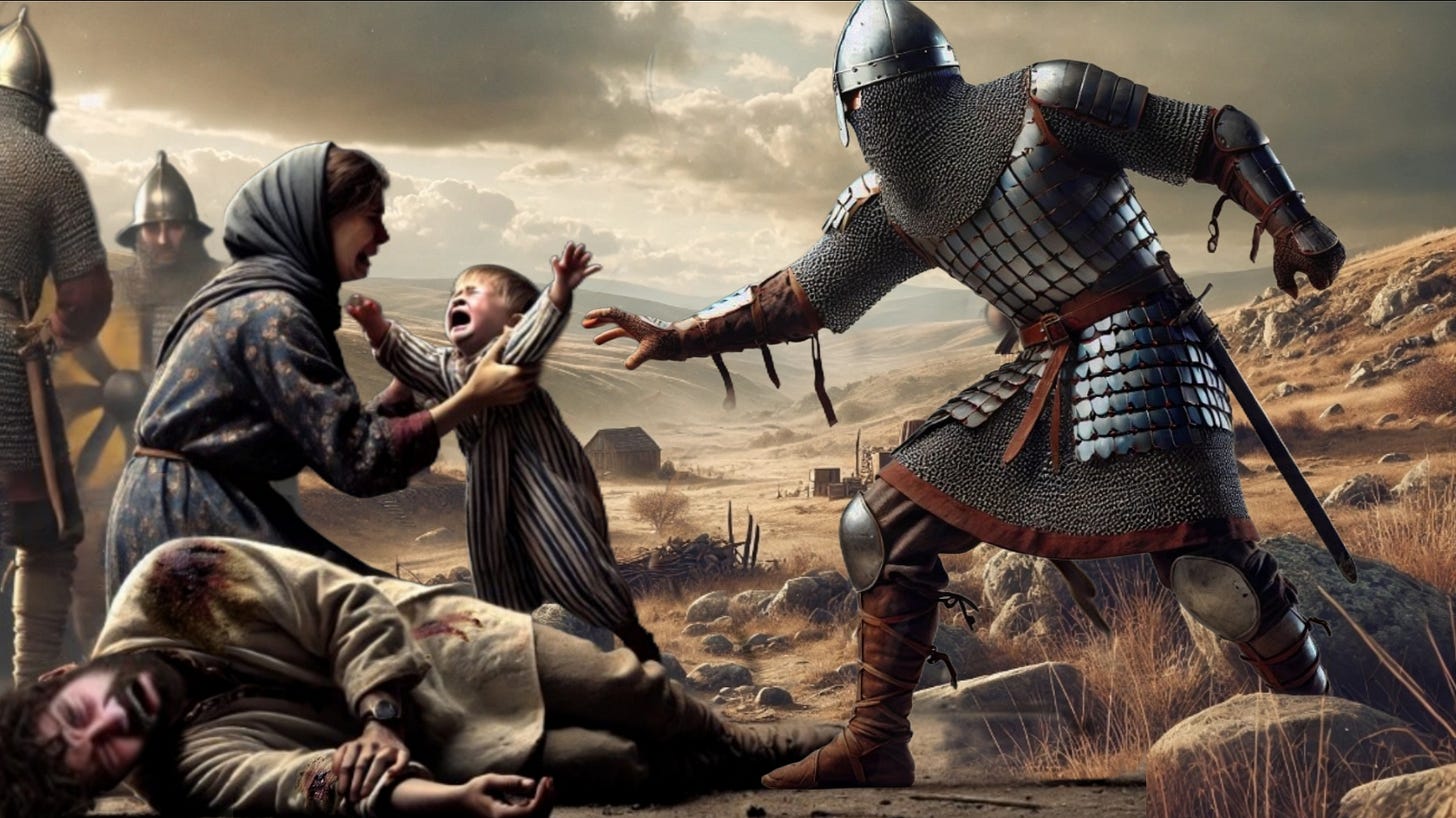
If you managed to get to the end of this thank you for not looking away.
Looking at it honestly:
Jesus taught:
Love your enemies
Turn the other cheek
Care for the poor and oppressed
Don't seek earthly power
Don't store up earthly treasures
True worship is in spirit and truth
His kingdom is not of this world
What Rome created was:
A powerful state religion
Systematic persecution of dissenters
Accumulation of vast wealth
Elaborate temples and rituals
Physical representations of divine beings
A hierarchical priesthood
Empire building through force
Murder of those with different beliefs about Jesus
The contrast is stark. A Jewish teacher who rejected earthly power and taught love of enemies was transformed into a Roman-style god, and his message of peace was used to justify torture and killing. Those who maintained beliefs closer to early Jewish-Christian understanding were branded heretics and eliminated.
This concludes the persecutory phase, stay tuned for the conquest phase….
Thanks again for reading. May God bless and protect you.
Revelation 18:5-6:
"For her sins have piled up to heaven, and God has remembered her crimes. Give back to her as she has given; pay her back double for what she has done. Pour her a double portion from her own cup."




